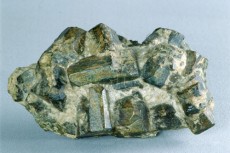|

Introduction
Cordierite is named after P.L.A Cordier, the French geologist who first discovered it. The gemstone variety of this mineral is called Iolite or Dichroite. The name Iolite has its stem from Greek, meaning “violet”, which represent the characteristic colors of gemstone grade cordierite. Exhibiting prominent pleochroism, cordierite may change its color depending on the angles of observation. Its chemical composition is silicate rich with iron, magnesium and aluminum. Magnesium in these minerals may be replaced by iron or manganese, and portions of aluminum may also be replaced by iron. The crystals of cordierite are columnar and short, and inclusions such as sillimanite, spinel, zircon, apatite, and mica are occasionally found in them. The colors may appear pale blue, deep blue or grayish blue; some maybe transparent, white, gray, pale yellow, purple or brown. Weathered cordierites may carry shades of green, and if the weathering continues, cordierite may become mica, chlorite or talc.
Cordierite typically occurs in rocks with high aluminum contents and transformed by middle to high thermal contact metamorphism. They can be found in gneiss or schists with high aluminum contents. Good quality gem grade cordierites are produced in Sri Lanka and India; some of them are also found in Germany, Myanmar, Tanzania, Finland, Madagascar, and the United States.
Physical properties
Crystal system: orthorhombic
Crystal habit: short columnar
Aggregate: granular, massive
Mohs scale hardness: 7
Cleavage : Fair on {100}, poor on {001} and {010} , Conchoidal to irregular-shaped fracture
Luster: From greasy to vitreous
Color: Blue, bluish green, gray, purple, brown, yellow or white
Streak: White
Specific gravity: 2.53 - 2.65
Other features:
(1) Tenacity: brittle
(2) Refractive index: 1.542 ~ 1.551
(3) From transparent to translucent
(4) Crystals may have repeated twinning that may appear pseudo hexagonal.
Chemical properties
Chemical components: (Mg, Fe2+)2Al3 [AlSi5O18].H2O
Chemical type: silicate minerals
Chemical characteristics:
(1) Magnesium can be replaced by a small amount of manganese
(2) Aluminum can be replaced by iron with high valence
Occurrence
Cordierite can be found in gneiss or schists with high aluminum contents, in granites or volcanic rocks, and may also be found to co-exist with garnet, andalusite, corundum, quartz, spinel, and sillimanite.
Major deposits
I. Taiwan:
(1) In andesites found on the Green Island and Orchid Island.
(2) In andesites found in Shamoshan of northern Taiwan and on the Turtle Mountain Island off the coast of Yi-Lan.
(3) In basaltic rocks on the Red Island of Penghu
(4) In slate rocks found on the Nenggao Mountain of the Central Mountain Range.
II. Rest of the world:
(1) USA: Haddam, New London, Guilford and Plymouth of the state of Connecticut.
(2) Canada: on the Garnet Island of the Northwest Territories.
(3) Germany: Bodenmais and Wechselburg of the Bavaria area.
(4) Czech Republic: Biskupice, Dolni Bory, Vezna
(5) Finland: Orijarvi and Pielavesi
(6) Norway: Kragerö, Arendal and Bamble sectors
(7) Sweden: Naversberg
(8) Spain: Cabo de Gato
(9) Greenland Tajik: SW of Rankful, the Sasyksky area
(10) Madagascar: Mt. Bity
(11) Sri Lanka
(12) South Africa: Blue Dragon mine in Cape Province, Guadon Farm in North Cape.
(13) Australia: White Well of Western Australia
(14) Brazil: Umburang, Paraiba
(15) Argentine: Soto
(16) Mexico: Parral, Chihuahua
(17) Burma
(18) Tanzania
Main purpose
Corderites that are exceptionally colored and transparent can be used for gemstones (Iolites). These stones are often colored blue or violet. Iolite is also known as “Water Sapphire” for its beautiful blue color.
Identification features
(1) Refractive index: 1.542 ~ 1.551
(2) Mohs scale hardness: 7
(3) Cystal habit: pseudo hexagonal, short columnar
(4) Color: blue or grayish blue
Although Iolites look similar to blue sapphires, they have obvious pleochroisms, and their hardness, RI and specific gravity are lower than sapphires.
The international digital archives and e-learning communication project of the National Museum of Natural Science
|